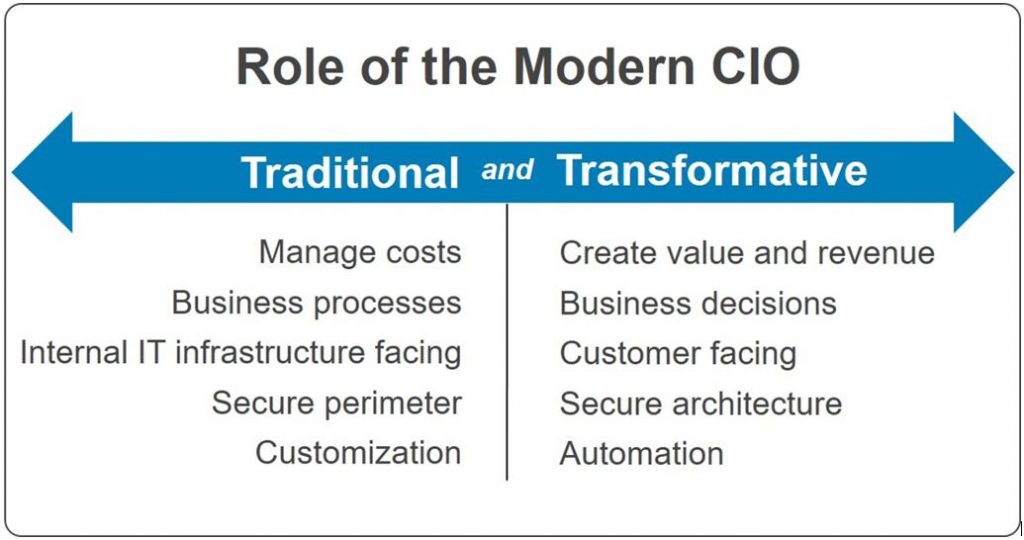For the senior IT manager looking to stay ahead of digital transformation trends, the scope of responsibilities have dramatically changed from just a few years ago. For a successful digital transformation, this means taking on new responsibilities in addition to managing traditional roles. In the whitepaper, “The Modern CIO: Digitally Delivering Business Transformation,” I’ve laid out five key areas that contrast the CIO’s traditional responsibilities with corresponding new behaviors that can help you drive effective business transformation.

1) Manage total cost of ownership (TCO) AND create value and revenue
Decades ago, early digitization projects focused on implementing financial software in order to streamline costs. Lower TCO ever since has been one of the key measurements for IT project success. Flash forward several decades and IT spend in many organizations has now moved outside of the official IT organization. Leading analysts have seen at least 29% of IT spend now taking place outside the IT organization on initiatives that have direct revenue impact.
The trend to digitalization has caused IT to change from a cost center to a profit generating business driver. 63% of CIOs today see their key focus now is to make money as opposed to mainly saving money for the company.
2) Manage business processes AND deliver business decisions
Big data and data analytics are key cornerstones to many digital transformation projects. Mobility, Internet of Things, and social media are resulting in an explosion of data. All of this data provides an enormous opportunity for you to gain business insights that can produce greater revenue and profitability through efficient, data driven decision making.
Sensus, an energy and utilities business, is an excellent example of this. By creating a data lake they were able to use the Dell EMC PowerEdge 730xd to manage the huge amounts of data they were gathering to make faster decisions on devices they have in the field. They took a process analyzing over 200 terabytes of real-time data, and shortened analysis time to less than a minute. Using IT as a business driver enabled them “to provide faster and more accurate results to the business so that we make really good decisions with real data.”
3) Maintain internal IT focus AND increase customer focus
Senior IT management still is the point of contact for the internal IT infrastructure, but in this new era you also need timely insights into what your customers care about. In a recent survey, CIOs stated that better engagement with customers was a key priority with 40% of CIOs spending at least one day out of their week outside of IT.
Following this trend, Anana, a contact-center organization, used IT to gain closer customer interaction by deploying a cloud solution with a strong social media platform using the Dell EMC PowerEdge FX architecture. Anana offers an excellent example of how to convert customer contact away from telephony and toward social media, web chat, and mobile apps. This can enable you to reduce costs and directly improve your customer’s experience.
4) Block external security threats AND internal security exploits
As the physical and virtual infrastructures of businesses have blurred, the potential increase for cyber-security breaches has grown exponentially. There was a time when having a strong firewall and updated anti-virus software was considered sufficient to secure valuable business data. This was an outside in approach. With the growth of mobility and IoT, the list of “insiders” for you to worry about has expanded. Once security exploits gain entry, malware can rapidly spread through east/west data center traffic throughout your IT environment.
Modern security requires proactive security features built directly into the IT infrastructure. The Dell EMC integrated Dell Remote Access Controller (iDRAC) brings security right into the hardware. It offers an inside out approach from deployment, to repurposing, monitoring, upgrading, and decommissioning. It’s a lifecycle of security built directly into the DNA of the IT infrastructure.
5) Utilize customization AND automation
An inadequate skillset has been cited as one of the top barriers to digital transformation. Many organizations find it difficult to hire employees with the skills needed, delaying their business transformation goals. As a result, they often turn to expensive third parties to provide time-intensive customization work required for the transformation.
Automation offers a key solution to the skills shortage. By deploying automation tools, your skills shortages can be alleviated and time to transformation can be accelerated. Liaocheng University is an example of an organization that completed a digital transformation product by creating a “smart city” solution based on the Dell EMC PowerEdge FX2. They were able to manage their skill shortage by automating application deployment and in the process decreasing deployment time by 85%!
Check out the whitepaper for other great examples of how to do big things for your business with digital transformation and Dell EMC PowerEdge server technology.